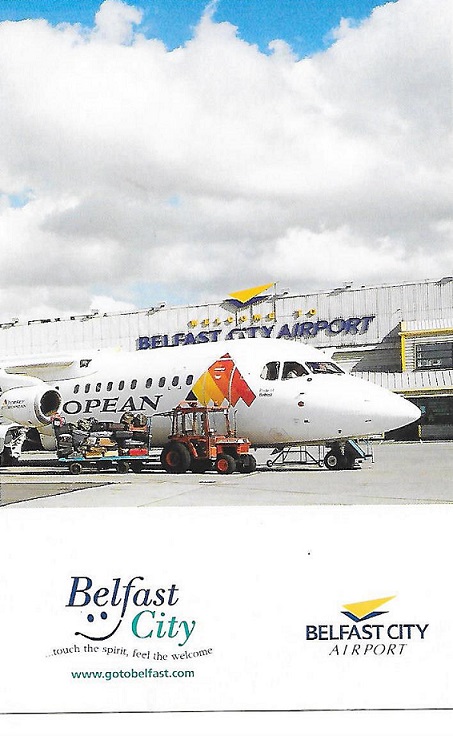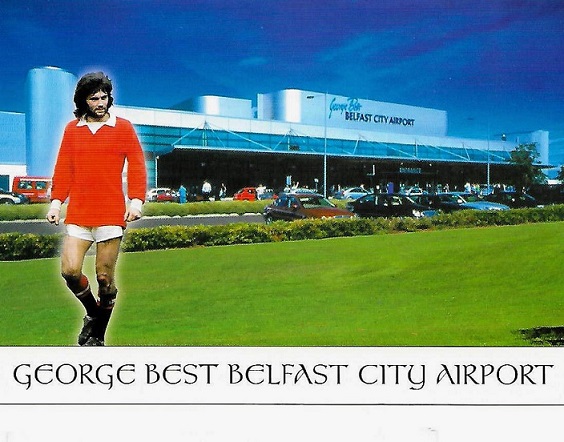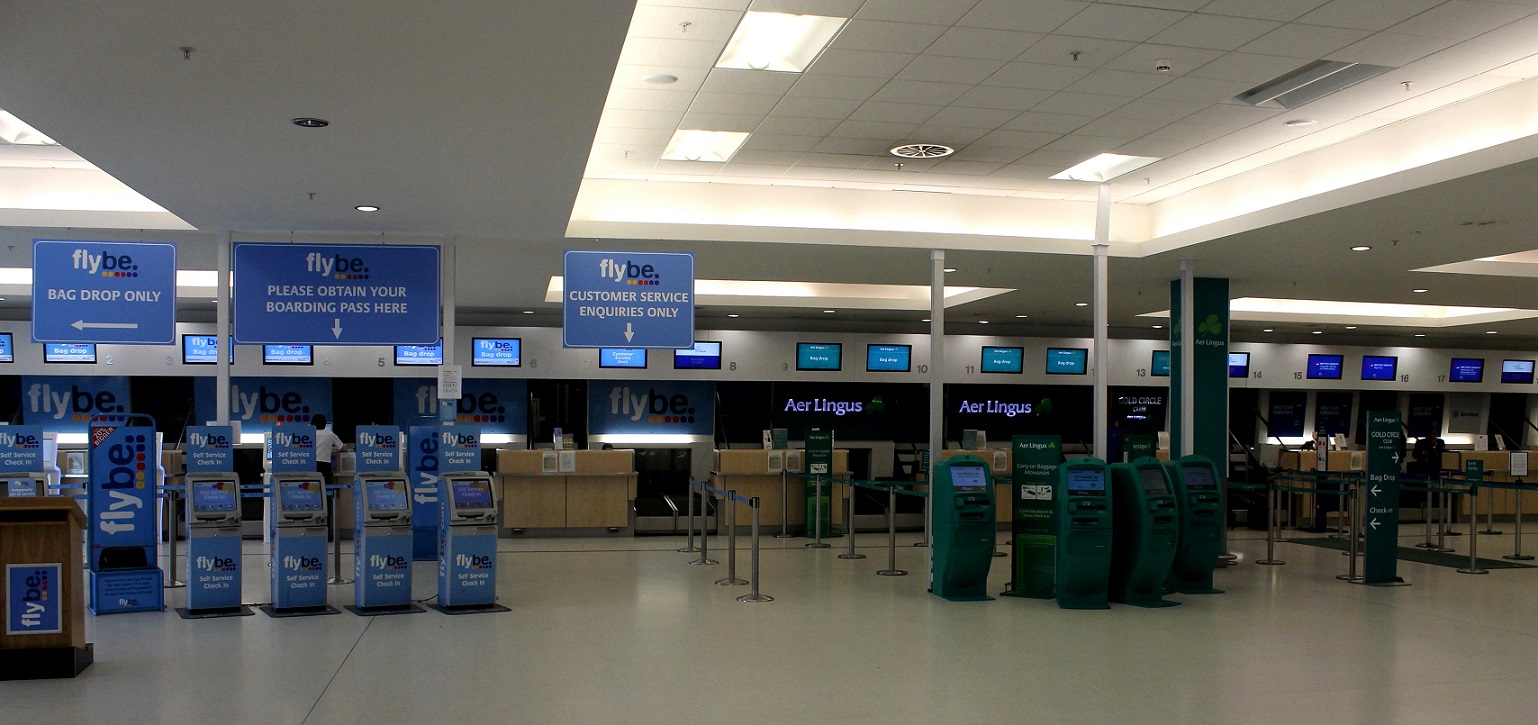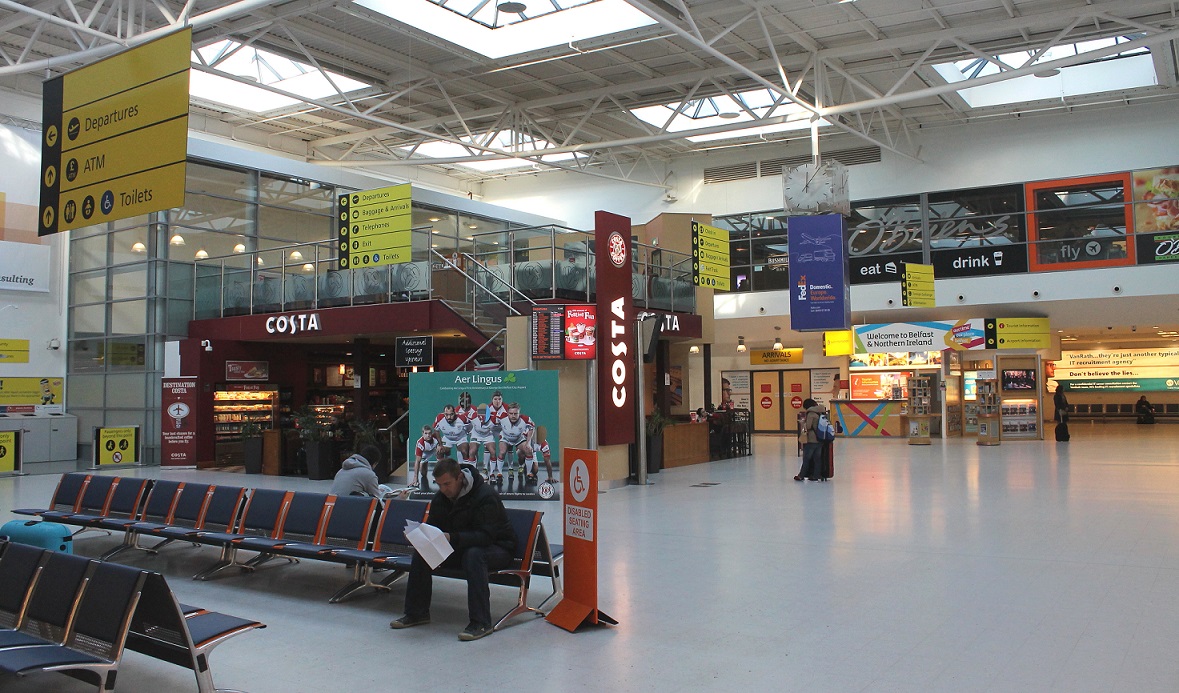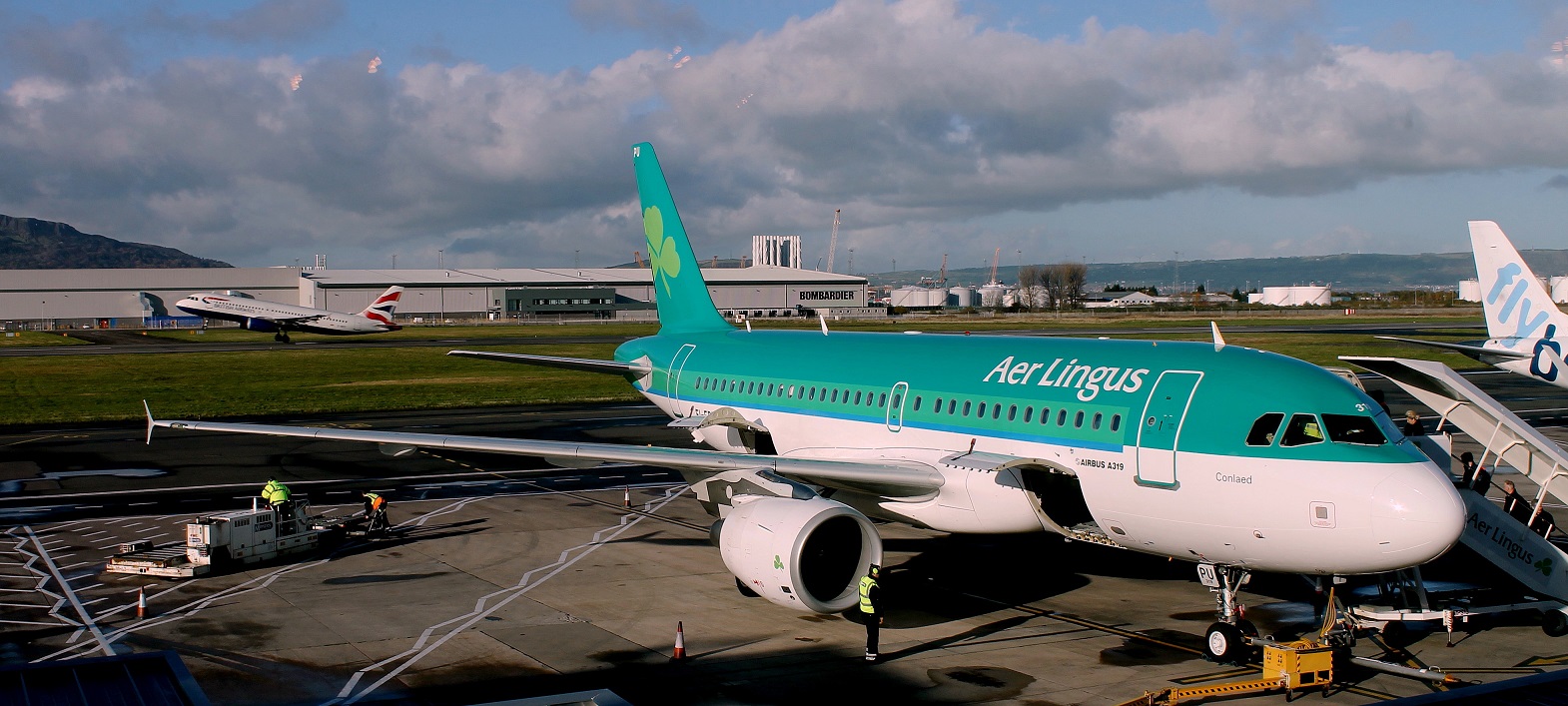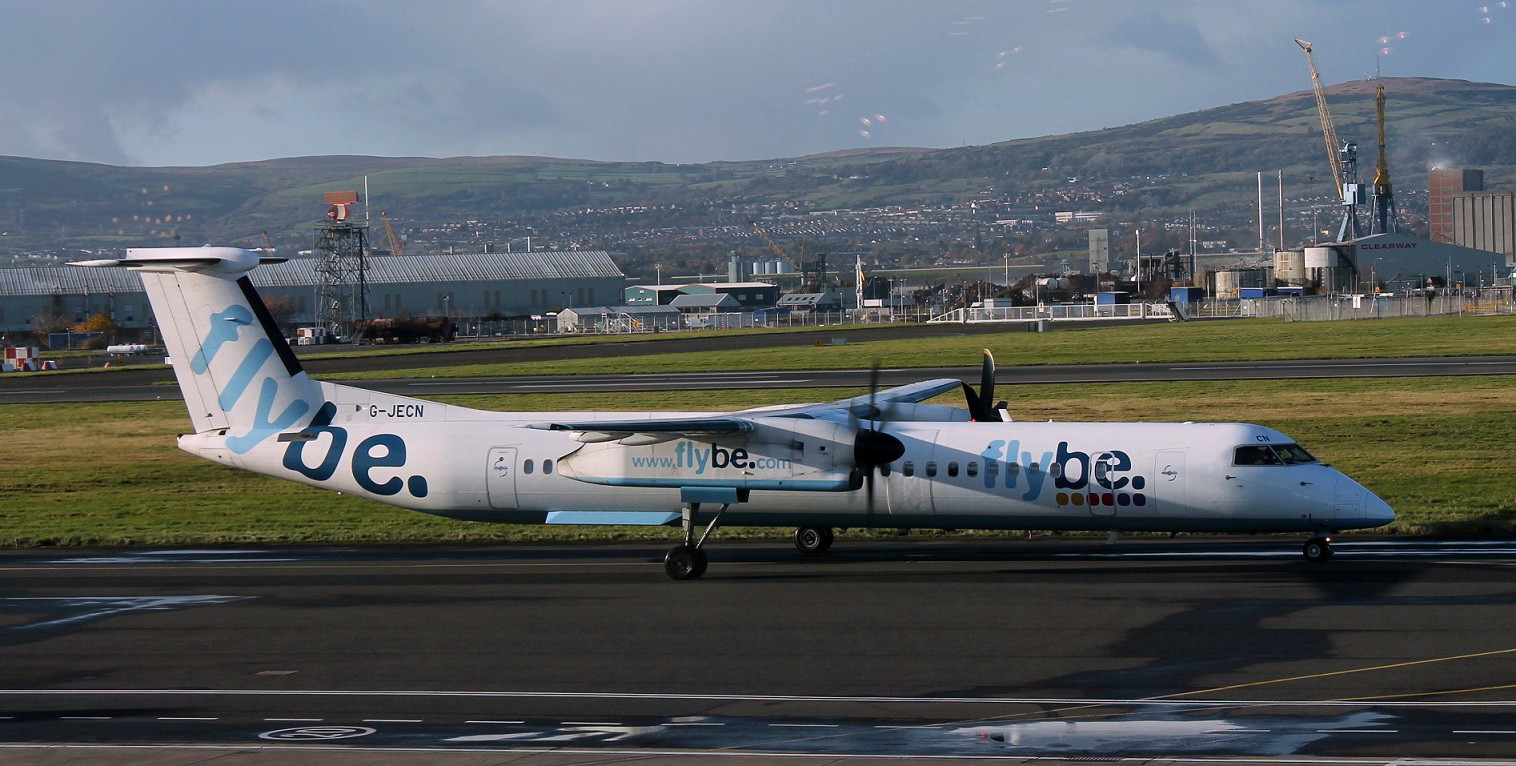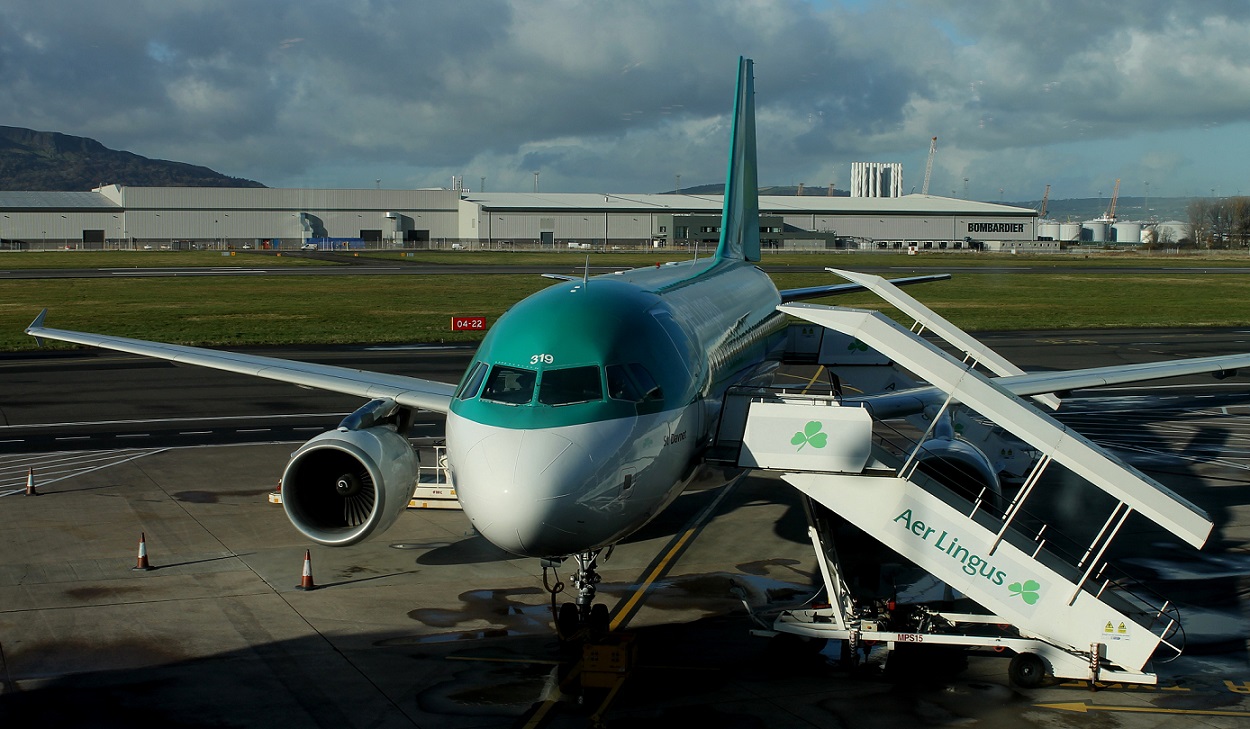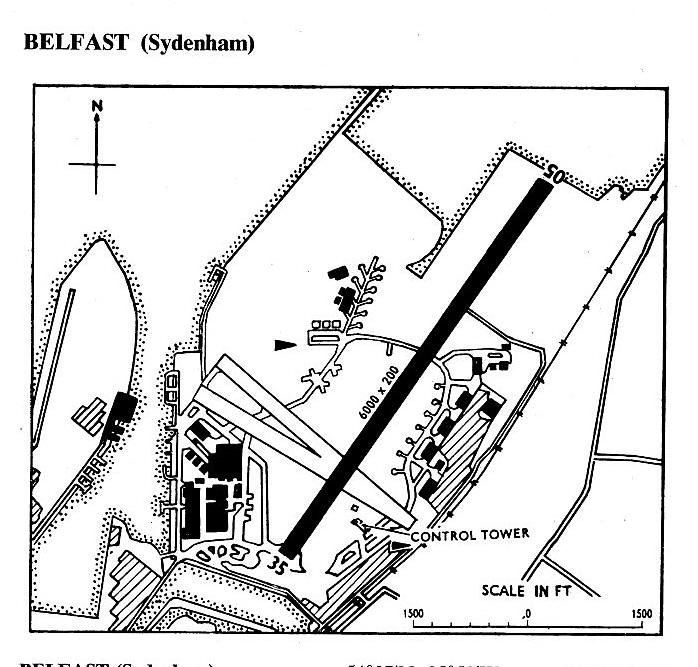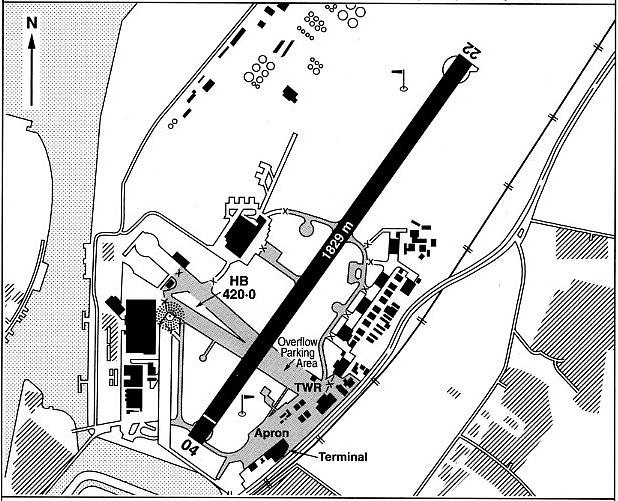Belfast (City)
BELFAST (CITY) : Civil aerodrome later military aerodrome and Royal Naval Air Station. Now civil regional airport
(Also known as BELFAST HARBOUR. Originally known as SYDENHAM)
Note: This two pictures, from postcards were kindly sent by Mike Charlton who has an amazing collection: See, www.aviationpostcard.co.uk
First picture. This probably dates from the 1990s.
Second picture: Probably 2006, or thereabouts.
On the 22nd May 2006 renamed GEORGE BEST BELFAST CITY AIRPORT
Note: All pictures below by the author unless specified.
Military users: WW2: RN (HMS GADWALL) (1948 Books of HMS GANNET)
RAF Bomber Command
88 Sqdn (Bristol Blenheims, Douglas Bostons & Fairey Battles)
226 Sqdn (Havocs & Bostons?)
1948: RN Aircraft Maintenance Yard
1975: FAA Storage Unit
1980s: Queens UAS [University Air Squadron] (Beagle Bulldogs)
13 AEF [Air Experience Flight] (Bristol Bulldogs)
Flying club/school: 1959 ‘snapshot’. Ulster Aeroplane Group (listed as based at SYDENHAM)
Gliding: 1997: 664 VGS (Volunteer Gliding School)
Operated by:
1965: Short Bros and Harland Ltd
1990: Belfast Harbour Airport Services
2000: Belfast City Airport
British airline users: Post 1945: BEA, BMI & BMI-baby, Community Express, easyJet, Gill Aviation, Flybe, Jersey European Airways, Manx Airlines, Manx2
Foreign airlines: Post 1945: Aer Arann, Aer Lingus, Ryanair
Manufacturing: Short & Harland (From 1936 to….), Bombardier
Location: N of A2, E of Belfast docks, 2nm ENE of Belfast city centre
Period of operation: 1936 (some say 1938) to present day
Note: These maps are reproduced with the kind permission of Pooleys Flight Equipment Ltd. Copyright Robert Pooley 2014.
Runways:
WW2: 04/22 1005x61 hard 14/32 1005x61 hard
1965: 05/23 1829x61 hard
2000: 04/22 1829x61 hard
NOTES:
I would recommend reading Ron Smith's British Built Aircraft Vol.5 to try and get a handle on this site. It would appear from his and other various sources that SYDENHAM was the main site for final assembly/flight testing for landplane types produced by Short & Harland. Their flying boats were flying from BELFAST LOUGH which I think is probably also known as the MUSGRAVE CHANNEL? (Although this was probably just the launching site?) He also says Short & Harland used ALDERGROVE, LONG KESH and NUTTS CORNER.
Reading Ron Smith's account certainly does seem to illustrate just how far divorced from reality so many people in the RAF and the Air Ministry were in 1939? When it was so obvious WW2 was on the cards and indeed, a major mobilisation programme had already been in place. For example, it appears Short & Harland built fifty Bristol Bombays, the first of which, L5808, first flew from SYDENHAM in March 1939! This being not too far short of building replicas of HMS Victory to face the Bismark battleship. Mind you, perhaps this a bad example to choose for a comparison, because it turned out that German battleships, or the Bismark at any rate, did not have ranging mechanisms to attack aircraft flying as slowly as Fairey Swordsfish! Which is why the attack on the Bismark, in the Atlantic on the 26th May 1941, by 'Stringbags' from the carrier HMS Ark Royal, was successful.
Perhaps Ron Smith has made a mistake, stating that the Short Brothers Bristol Bombay first flew here in 1939? Because, Ron Smith then says the next production was for 150 Handley Page Herefords. “The first Short-built Hereford was L7271 (a conversion of the HP53 Hampden prototype), which flew on 6 October 1936.”
THE SHORT STIRLING
The biggest contribution to Bomber Command in WW2 by Short Bros and/or Short and Harland was the Stirling. This was the first of the big four-engined bombers and today it is largely disparaged, which really is unfair. When it was designed and first flown the Stirling was a huge step forward and a very formidable weapon. It is sometimes forgotten that in a major war scenario the rate of progress is such that front line aircraft quickly become obsolete.
It is claimed 2,283 Stirlings were produced, 1,218 in Belfast, the first example L6000 flying on the 28th October 1940. In ROCHESTER (KENT) and SOUTH MARSTON (WILTSHIRE) it seems a further 545 were built. The LONGBRIDGE (WEST MIDLANDS) or Austin Motors car factory produced 191 examples. Which adds up to 1,954 - so where were the other 329 examples built?
THE SHORT SUNDERLAND
An equally if not more famous Short type in WW2, was the Short Sunderland flying boat. It appears only 133 Short and Harland examples were built, the last Belfast built example, SZ599, first flying on the 14th June 1946. In fact, as far as I can see only 749 Sunderlands were produced? One source says that many of the Belfast built examples, all of which were built towards the end of WW2, were towed out into the sea and scuttled after WW2 ended.
The last Belfast-built Sunderland SZ599 was flown on the 14th June 1946 by round about which time they were converting existing Sunderlands into Sandringhams, for BOAC mostly I think? Qantas I’m pretty certain was another customer? They also converted ten Junkers 52/3m for BEA, and twelve Halifaxs to Haltons for passenger use by BOAC.
THE "BEA" JUNKERS
The Junkers Ju 52/3m were operated by Railway Air Services on behalf of BEA and served SYDENHAM for a short period, which appears to have been the ‘Belfast’ airport before NUTTS CORNER opened. In The History of British European Airways Charles Woodley says, “Despite the move to Northolt, some new routes were still being inaugurated from Croydon. On 18 November 1946, Railway Air Services, operating on behalf of BEA, opened Croydon – Liverpool – Belfast (Sydenham) services, using former Luftwaffe Junkers Ju 52/3m aircraft. From 16 December the Belfast terminal was transferred to the new Nutts Corner airport. Seems incredible? The effort to set up a terminal facility, (it might have been just a couple of tents of course), at SYDENHAM, lasted just under a month!
ANOTHER POSSIBLE MYTH?
It is often quoted that the case for big flying boats for use as civilian airliners ceased after WW2. They were redundant, relics of a past era. This is simply not true, the case if anything was more convincing for the British to develop very large flying boats to serve the Empire routes and in the UK Saunders-Roe especially knew this to be one of the ways to go. Unfortunately they were very seriously let down by Bristol, whose promised engines were a complete disaster. See COWES (ISLE of WIGHT) for more info.
By this time of course the Americans had a huge industrial base churning out airliner land-planes produced by Boeing, Douglas and Lockheed and this was the way they wanted long distance air travel to go. It seems often forgotten that to service these mostly American airliners, dozens of new, large and expensive airports had to be constructed, whereas all the flying-boats needed where facilities that already (more or less) existed. These Empire routes had been well served by flying boats in the 1930s and it seems to me at least, that if types like the Saunders-Roe Princess had been progressed, then surely they had a viable future. Water provides for very cheap long 'runways' and, there are no technical reasons why powerful jet engines cannot be used. Another aspect that also seems ignored today, is that the sheer size of the Princess is the 'missing link' between airliners of the 50s and 60s and the Boeing 747 'Jumbo jet".
A NOVEL MIX OF NEW TYPES
From the late 1940s Short 7 Harland produced a mixture of new designs of civil, experimental and military types of varying sizes, the first of which was a Grumman Mallard 'look-alike', the Sealand, the prototype of which (G-AIVX) first flew from BELFAST LOUGH on the 22nd January 1948. The Sturgeon RK791 was unsuccessful against the Fairey Gannet although it seems 27 of different variants were built, many going straight into store. Other types included the SB.1 Sherpa (G-14-5), which first flew as a glider from ALDERGROVE. Then came the SA4 Sperrin VX158 ‘V’ bomber followed by the SB5 which was more or less an English Electric P.1, (which became the Lightning), with a fixed undercarriage for low speed trials.
The SB6 Seamew XA209 first flew on the 23rd August 1953, another project which was a failure. Bristol set up a second production line for the Britannia to build the military version for the RAF, the first Britannia C.1 XL635 flying on the 29th December 1958. No two week close-down for Xmas in the UK in those days! What I certainly did not know, but do now thanks to Ron Smith, is that a fuselage production line for the de Havilland Comet 2 was set up, to augment Hatfield when the orders came flooding in.
Following on was a remarkable success, albeit a purely experimental type, the Short SC1 VTOL of which two examples were built, XG900 and XG905. Both of which served for years, mostly at RAE BEDFORD, (THURLEIGH) but also BOSCOMBE DOWN. It was at RAE BEDFORD, on the 6th April 1960 that XG905 became the first VTOL jet to make a full transition between hovering and conventional flight. By comparison the next type was, I would say, an equal manifestation of genius, the Skyvan, although it appears the actual design was a rehash of the Miles HDM.105 for which Shorts had aquired the design rights. The prototype G-ASCN first flew from SYDENHAM on the 17th January 1963.
A LACK OF IMAGINATION?
I have long believed that only the very best designers produce the classic aircraft - regardless of size or status. Jumbo jet or Tiger Moth, it doesn’t matter. I can clearly remember going to a FARNBOROUGH Air Show with my wife in the 1970s and reckoning the game was up for the UK aviation industry, a spent force defeated by a combination of global influences and politics. Probably for most spectators Concorde was the ‘star’ of the show, it was certainly bigged-up that way. But when the Brittan-Norman Islander flew I told my wife, “That is what we British really should be backing, and that is where our future lies.” Forty years later I am quite proud of that assertion. The Skyvan and Islander were very successful and I’d add the Europa and Streak Shadow as being superb examples of how we Brits can excel, but we can’t as a nation depend on our government to do the ‘long term’ commitment. Something I still cannot fully understand is - why not?
Surely determined development and aggressive marketing of these two types should have ‘wiped the floor’ in the Third World markets?
Perhaps it was the sheer cost of Concorde that, in part at least, put paid to much of the will of the British government to back home-grown aircraft. On the other hand we had the Harrier, BAe 146 and BAe Hawk as sucess stories too. But then again the French can do it, and have with Airbus Industries, to which we now contribute components as sub-contractors.
HARPING ON
To harp on again, is it not interesting at least, to note the French have aggressively resisted any interference from the USA. Whereas we bend over backwards if they even utter a sigh of discontent with our stance. But, what I can’t get my head around is – how exactly did this happen? They certainly didn’t support us in the early stages of WW2, then saw an opportunity to nigh on bankrupt us with Lend-Lease, and when push came to shove when they saw the threat from Russia to conquer western Europe towards the end of WW2. The war with Germany was all but over in 1943 with the brutal RAF Bomber Command campaign being constantly strengthened, but the Nazi regime couldn’t accept the fact. We offered our services as being the next best thing to a gigantic aircraft carrier. Who I now wonder, actually ended up paying for the multitude of airfields built in the UK for the Americans to base their aircraft?
Whether or not the Americans footed the bill, we Brits certainly did not have any choice in this. For the D-Day landings we certainly couldn’t have put enough boots and tanks on the ground to plough through the remnants of the Nazi war machine and end up effectively resisting the Soviet invasion of western Europe.
THE SHORT BELFAST
The above leads me rather conviently to the next major Shorts project, the Belfast, the prototype (G-ASKE/XR342) first flying here on the 5th January 1964. Generally regarded as a failure I think this is probably grossly unfair, the design being stifled from birth by lack of development expertise and funding? Only ten were built.
Exactly why the Belfast project went ahead seems a complete mystery; along with TSR2, built, flown and thrown away. Why? In the case of the Belfast it had the American Lockheed Hercules to compete against and the comparative performance of the two designs are, I think, worth looking at - on paper at least.
Short Belfast (1964) Lockheed C-130H Hercules (1980)
Max. payload: 36,288kg 20,000kg
Cruise speed: 358mph 336mph
Max. range: 5,200 miles 2360 miles
Ceiling: 30,000ft 23,000ft
So, on paper it is absolutely clear the Belfast ‘knocked spots’ of the Hercules in every respect but I did get this information from the internet, mostly from Wikipedia – therefore somewhat suspect? What idiot claimed the Belfast could reach 30,000ft, it now appears it could barely reach 12,000ft half loaded. But, the design potential was very obviously intended to be vastly superior to the Hercules, and, given development there is probably little reason to believe the end result could easily have achieved these results? The two most important criteria for a military transport aircraft in those days were surely payload and range? Still valid today of course but with altitude (service ceiling) now being much more important. The designers of the Belfast intended to pretty much double both the payload and range over the Hercules. But the project was stifled almost from the outset. Why?
OTHER ACTIVITIES
During the 1950s Short & Harland were contracted to carry out repair, modification and overhaul work on the Hawker Sea Hawk, Vickers-Armstrong Scimitar and the de Havilland Sea Venom. Later they built eleven VC.10 fuselages for the RAF contract but the most significant contract was for the English Electric Canberra of which 144 variants of the B.2, B.6, B(1).Mk 8 and PR. Mk 9 were built, plus two prototypes and 24 production models of the unmanned U.10 and six U.14s.
THE 1970s
In 1975/77 this sit was still referred to as SYDENHAM and at that time Short Bros were building later Skyvan variants, SD330s and then the SD360, the first example of which (G-ROOM) first flew on the 1st June 1981. Military versions were built too. As many pilots used to say of these aircraft; “It might well be a fine looking aircraft when they take it out of its box.” 164 civil SD360s were built, the last flying in June 1991. Over the years I have met a few pilots who have flown these utilitarian aircraft and they all appear quite happy with the type. There is nothing glamorous about the duties they were designed for, but commercial aviation across the world has a considerable requirement for such aircraft.
In 1977 it appears the following aircraft were based here: Beech 65 A80 Queen Air G-ASVE, Shorts S.C.7 Skyvan 3A G-ASZJ, plus two Shorts SD330s G-BDMA & G-BSBH all of Short Brothers & Harland Ltd, plus the Scheibe ST-27M G-AWSX and PA-18 Super Cub G-BAVA
A CHANGE OF NAME
The company name was changed to Short Brothers Ltd in 1977 then again to Short Brothers plc in 1984. The company gained a contract to supply 130 heavily modified versions of the Embrear Tucano to the RAF. 131 were actually built, one example being destroyed by a bomb, presumably a ‘gift’ from an IRA faction?
In 1989 the Canadian Bombadier Inc purchased the company and in common with most major British aircraft manufacturing facilities, they also make parts for other aircraft manufacturers, which I suppose is no bad thing as they appear to be very successful. In around 2019 Bombadier put their facility up for sale. Did Airbus take it over?
We'd love to hear from you, so please scroll down to leave a comment!
Leave a comment ...
Copyright (c) UK Airfield Guide















